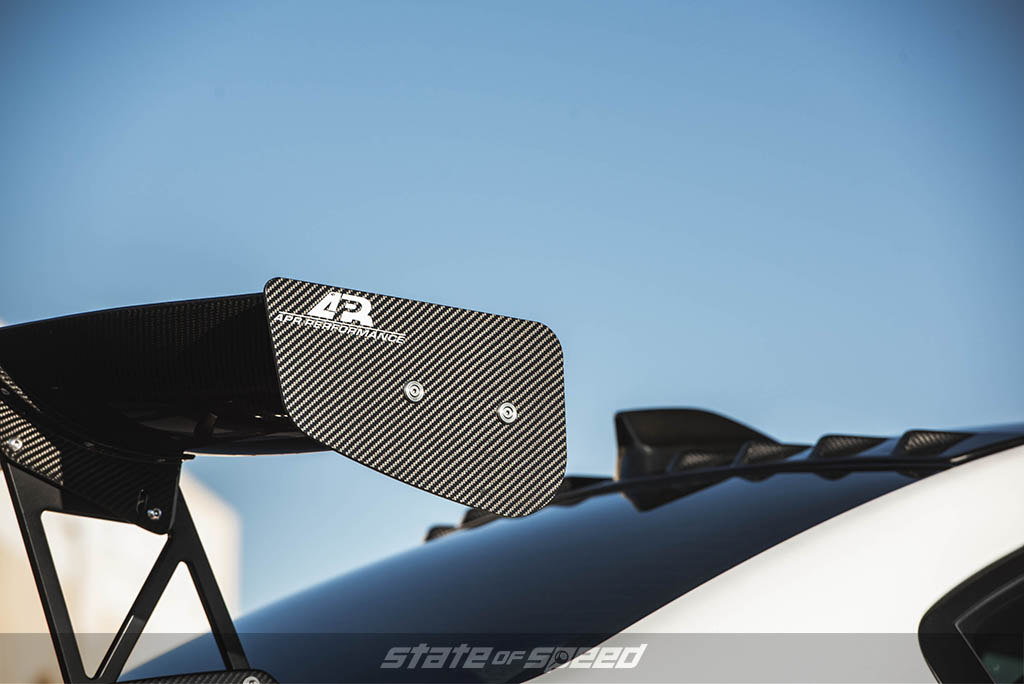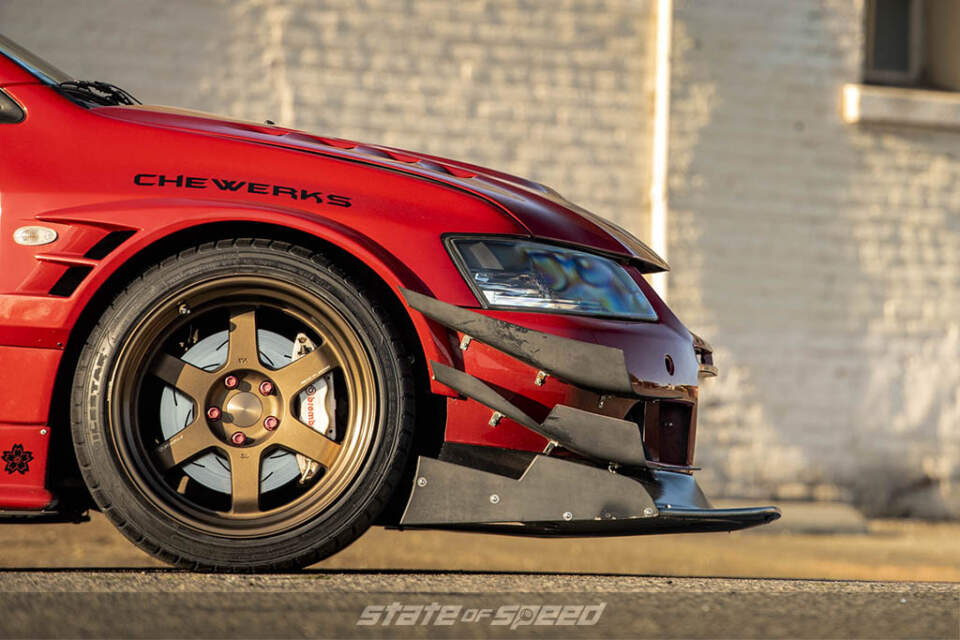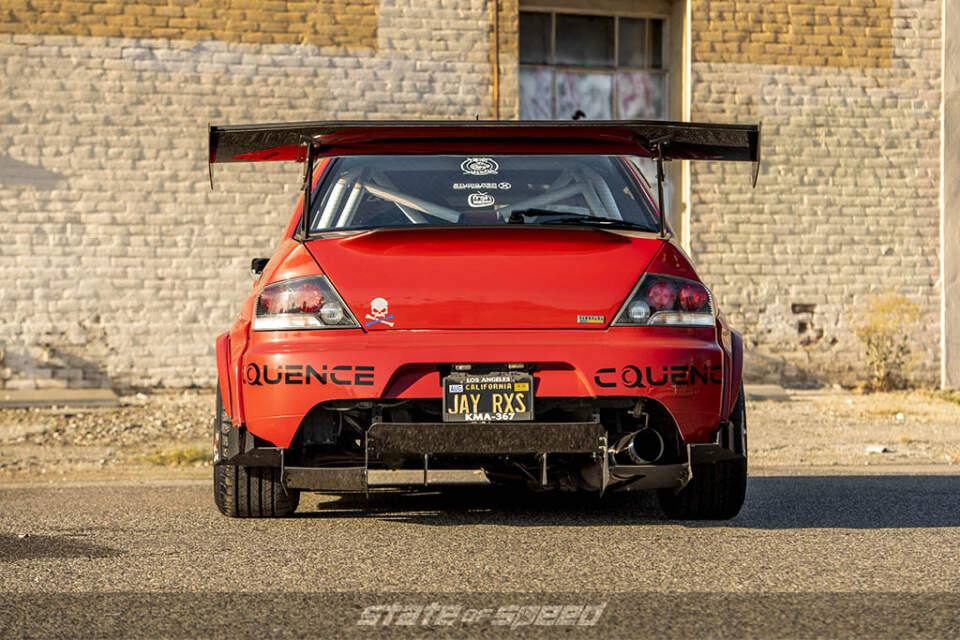A Streamlined Guide to Aero
What Do All Those Wings and Fins Do, Really?
Getting into the subject of aerodynamics as they relate to cars is asking for trouble. Whether you’re talking about imports with big goofy wings and dive planes that look like anime road catfish, or even just owners of a certain domestic brand who steadfastly refuse to remove the banana-yellow shipping guards on their cars’ factory splitters, it’s a topic that draws a lot of derision. Sometimes that’s warranted, but there is a place for aero mods in the tuner’s toolbox. Understanding the goals of functional aero is the first step in moving from the realm of questionable styling choices into something worth doing for the sake of improved performance. We’re going to jump in with both feet and banish the poser-tech to the Land of Wind and Ghosts, so hang on…

No Free Lunch
Aerodynamic modifications to a car serve one or both of two main functions; reducing drag and reducing lift. Most changes affect both drag and lift, and while downforce can be important, achieving meaningful results in that area without a huge drag penalty can require some finesse. Drag is especially important because it increases with the cube of velocity – drag-inducing elements of a vehicle’s design that aren’t worth worrying about at low speed become big problems on the highway or racetrack. Like almost any part of car design, the ability to maximize the desired effects while minimizing the drawbacks is what separates winners and losers.

Tires: Milestar MS932 XP+
An excellent example of this that’s become ubiquitous over the last two decades in OEM car designs is limiting the volume of air that passes underneath a car. In older designs, this was a source of both lift and drag, and as a result, modern vehicles have become lower and they’ve added aerodynamic features to the nose of the car to redirect flow. These changes cost virtually nothing for manufacturers to implement but provide real benefits.
One area of special attention that was often poorly-understood or simply ignored in the past was air passing through the front grille, into the engine bay, and out through the open underside. Smaller air inlets better-sized to the radiator core and ‘bottom breather’ noses that actually relieve pressure at the lowest point under the bumper, plus aerodynamic trays covering the underside of the engine compartment are all examples of the way modern designs improve aero in this region.

We have to admit that we’ve been among those who have either intentionally removed an engine bay undertray to make maintenance less of a pain, or simply lost one due to ill-advised encounters with curb stops or speed bumps, but not having them in place as intended is a significant source of both drag and lift. There’s little point in trying to improve aerodynamics at the nose of the vehicle with added parts if the primary flow-control features of the factory design are missing.

Presuming that you’re starting from an intact, OEM aero standpoint, is it possible to modify things yourself and achieve meaningful, non-cosmetic results? The answer is a qualified yes – like every other aspect of automotive engineering, factory designs are always a compromise between competing goals, and the compromises you might choose as an enthusiast aren’t always the same as the ones that are aimed at satisfying the greatest number of ‘normie’ potential customers. In the case of aero, low drag, stable handling at freeway speed, and low noise top the factory wish list.

As an enthusiast, you may be willing to trade away some extra drag (and lose a bit of fuel economy at cruise) in exchange for added downforce to improve traction. Increased wind noise may also not be a concern for you, and you might be willing to accept the negative consequences of a lower ride height, like increased susceptibility to damage from potholes and curbs. These are just a couple of considerations when planning out aero changes to your vehicle.

With all this in mind, let’s start from the front and work our way back, describing different aero components and how they function (or at least are supposed to function).
Nose Dive
It used to be that air dams with splitters (a horizontal plate attached at the bottom of the air dam) were only seen on race cars, but they’re appearing with greater and greater frequency on factory cars as well – often with the aforementioned plastic protective bananas still attached, because reasons. The purpose of a splitter is to cleanly divide flow between the air moving around and through the nose of the car and the air traveling underneath the body, as well as limiting how much air goes low instead of high. To be truly effective, splitters need to be quite close to the ground, and even though factory-designed ones are usually higher than ideal, they still provide an endless source of horrible scraping noises over curbs, driveway entrances, and other obstacles if the driver isn’t careful.

Tires: Milestar MS932 XP+
A properly-designed splitter and air dam combo will reduce both drag and front end lift by reducing turbulent flow to the underbody, and will also help the engine bay tray (if present) to do its job. A secondary purpose is to help guide flow around the front wheel openings, which are a major source of drag.

Dive planes, canards, fins, or whatever you want to call other small aero devices placed on the quarter panel in front of the wheel arches also serve this purpose, as do longitudinal fences at the gap between the fender and the hood. Properly engineered canards can also help promote the flow of air from brake cooling ducts that source air from the high pressure area in the bumper by creating a local region of lower pressure to draw air away from the rotors and wheels after it has done its job.

Tires: Milestar MS932 XP+
Care has to be taken with hood fences, though – viewed in profile, a car is shaped somewhat like an airplane wing, and just like a wing, air that is accelerated over the upper side creates an area of reduced pressure, generating lift. Ideally, fences will keep high pressure air from spilling over the fenders (thus increasing front downforce) without forcing it to follow the curve of the windshield over, rather than around, the passenger cabin. Fences, as well as canards/dive planes to a lesser extent, can also greatly increase turbulence around external mirrors – while this isn’t a huge source of extra drag, it can create a lot of interior noise ranging from a very-low-frequency ‘brown note’ rumble to intolerable high-pitched whistling.

Side View
Extended lower sills along the sides of the body are another example of managing airflow beneath the vehicle. Like splitters, to be completely effective they need to be impractically (at least for on-road use) close to the ground, but they aren’t totally useless even when compromised for the sake of clearance.

Tires: Milestar MS932 Sport
An interesting side note here is that a number of competition vehicles, ranging from the 1970 Chaparral 2J Can Am car to modern Formula SAE karts have been built with ‘powered downforce’ using a fan to pull air from underneath the car. Working like a reverse hovercraft of sorts, the front, sides, and rear of the underbody were sealed to the road surface via flexible skirts with polycarbonate sliders at the bottom to reduce air leakage, and a slight vacuum created by the fan across the entire underside of the car delivered enormous downforce at zero MPH with no aerodynamic drag. It was said that the 2J could develop enough suction to allow it to stick to the roof of a tunnel at a standstill, and the pair of 17 inch fans, driven by a separate snowmobile engine, could drive the car forward at 40 MPH just by their thrust alone.

Of course, in Can Am competition the technology was immediately outlawed, as these things tend to be, but in racing situations where it isn’t outright banned by the rulebook, this unique form of “aero” is still an extremely effective one. In the real world with roads that aren’t billiard-table smooth, the skirts take a beating, and getting rocks and dirt actively sucked up through powered fans does not make the people driving behind you very happy. Nonetheless, a good front splitter and side skirts, combined with a rear end shaped to create a low pressure area can still take advantage of this same effect, though only in motion and with much less total downforce.

Tires: Milestar MS932 Sport
On the roof of the car, vortex generators can be fitted along the back edge just ahead of the rear window. These are small triangular features that are actually designed to create turbulence, but in a very controlled way. By inducing a narrow band of swirling flow, they act in the same way as a solid fence and can help keep flow attached to a surface, with a small drag penalty. Originally vortex generators (as well as fences) were found on aircraft wings as a way to stop span-wise (side to side) airflow and improve stall performance. In the automotive world, you’ve undoubtedly seen these on factory Mitsubishi EVO sedans, and their budget cousins can easily be found in the stick-on plastic whatsis aisle at your local auto parts store, alongside portholes, fake vents, and chrome Punisher symbols. Usually, these cheap little pyramids are poser tech, but they can actually be effective when used in the right spots. Unfortunately, without sticking tufts of yarn all over the outside of the car to see how air is moving locally across the roof and backlight, the ‘right spots’ are impossible to determine beyond an educated guess.

Winging It (Spoiler Alert)
Finally, we get to what you’ve all been waiting for, the defining piece of aero hardware – the wing or spoiler. First, though, please understand that the terms aren’t interchangeable, and although both reduce lift/increase downforce on the rear end of the vehicle, they do it in different ways. Let’s start with the simpler of the two, the spoiler.

The name for this aerodynamic device comes directly from its function; ‘spoiling’ the lift of a wing-shaped surface. Earlier, we described how the body of the entire car in side-view resembles an aircraft wing with a curved upper surface, and just like an aircraft wing, since air has to travel farther and faster across the top than the bottom, it will generate lift. A spoiler on the back of the car works exactly as it would on a wing, disrupting that flow of air to kill some of the lift being produced.

Tires: Milestar MS932 XP+
Just as importantly, a spoiler can actually reduce total aerodynamic drag despite being an impediment to the smooth flow of air. Back at the dawn of ‘streamlining’ (as aerodynamics were first called 100 or so years ago) inventors looked at the teardrop shape of a falling droplet of water and concluded that nature was providing them with a blueprint for the perfect low-drag shape. As a result, a lot of the first efforts at streamlining included long, pointed tails to allow the airflow to smoothly rejoin behind the vehicle without producing an area of low pressure.

Tires: Milestar MS932 XP+
As zippy as these designs looked, they were somewhat impractical for road vehicles, and designers searched for other solutions. The most successful was developed by a German fellow by the name of Wunibald Kamm in the late ‘30s when he discovered that an abruptly cut off vertical shape at the back of the car was nearly as effective in reducing drag as a pointed tail. By inducing some of the boundary layer air close to the surface of the body to tumble into that space behind the car, it created an area of turbulence that didn’t mix with the other air flowing around the car and worked like an invisible (and weightless) pointed tail.
Since that time, the “Kammback” has been widely adopted, and can be seen in cars ranging from the original Honda CRX to many modern hybrids. For best results, the vertical surface should be placed at a point where the body’s cross section has sloped back down to about 50% of its maximum, but this limits the workable roofline and tail shapes quite a bit. Add a spoiler to the trunk lid or the back edge of the roof on a hatchback, though, and you get a similar drag reducing effect as a full Kamm rearend.

Wings, particularly those that are intended to do something more than just look cool, are somewhat more complex. Ideally, a wing will be placed far enough away from the body of the car to be in “clean” air instead of sluggish and turbulent boundary layer flow. Interestingly, the 1969 Dodge Charger Daytona and 1970 Plymouth Superbird, with their fender-mounted ‘basket handle’ rear wings that were higher than the roofline had ideal placement for them, but it wasn’t for aero reasons – they had to be that high so that the trunk lid could still open underneath them!

A few years earlier, the Chaparral 2E Can Am design had debuted a tall strut-mounted rear wing that had what would be now considered “active aero” – A pedal on the floor would flatten out the angle of the wing and simultaneously close a shutter on the air dam that normally allowed air out through a vent in the front bodywork when depressed, letting the driver reduce drag when downforce wasn’t needed along high speed straights. The struts for the wing were also directly connected to the suspension, so force was applied straight to the rear tires instead of through the springs. While it worked very well, it proved to be fragile and after a few failures in the cars adopting these kinds of movable wings, they were outlawed (leading to the aforementioned Chaparral 2J ‘sucker car’).

Today, it is very common to see high-end (and even some not so high-end) sports cars with rear wings that automatically deploy and adjust their angle based on road speed and cornering forces. For aftermarket race-style wings, the angle of the airfoil (or in many cases, multiple airfoils) can be changed in the garage by altering the mounting points in order to customize the balance between drag and downforce for a particular race venue. Spill plates on the ends of the wing serve the same purpose as the winglets commonly found on commercial jets, reducing drag caused by vortexes shed by the ends of the wings.

It’s also worth noting that a wing can help high-speed stability side-to-side by moving the car’s center of pressure rearward. The center of pressure is the imaginary point where all the aerodynamic forces are balanced, and the farther behind the car’s center of gravity it is, the more the car will want to travel in a straight line. Any kid who’s built a model rocket and decided to put all sorts of fins on the front will tell you that having the center of pressure at or ahead of the center of mass gets you something that flies like a pinwheel instead of an arrow, and the same applies to car aerodynamics. We should also point out that the ever-popular ‘wing on the back of a FWD car’ isn’t necessarily just poser-tech. At high speed the car doesn’t care that much about which wheels are doing the motivating, and since FWD cars tend to have a forward weight bias in the first place, a properly-designed rear wing can greatly increase stability and cornering balance.

Finally, we get to the last details as we reach the very tail end of the car. Wings and spoilers often have small features on their rear lips to enhance their effectiveness, which can be either fixed or adjustable. A small tab, usually a half-inch high or less and mounted at the very trailing edge of a wing or spoiler at a right angle to the surface is usually referred to as a “Gurney flap.” It gets its name from the legendary racer and team owner Dan Gurney who came up with the idea as a quick handling fix for his driver Bobby Unser’s car. To hide the true purpose of the modification, he initially floated the story that it was just a way to protect crewmembers from the sharp trailing edge of the wing while working on or pushing the car, but soon enough everybody figured it out and it became commonplace in race car aerodynamics.

A taller, usually adjustable trailing edge lip is typically called a ‘wickerbill,’ and explanations for the name are easy to come by but none are definitive. These fall into the category of aero devices that can be tuned in the garage or pit to suit the race course by sliding them up or down in their mounting slots.

So there you have it – the incomplete guide to understanding car aerodynamics. We hope that we’ve fired your imagination and that you’ll follow up on the subject with further reading, since it’s a topic of pretty high importance for both factory and modified vehicles. Plus, aero stuff looks cool when it’s done right, but you already knew that…














